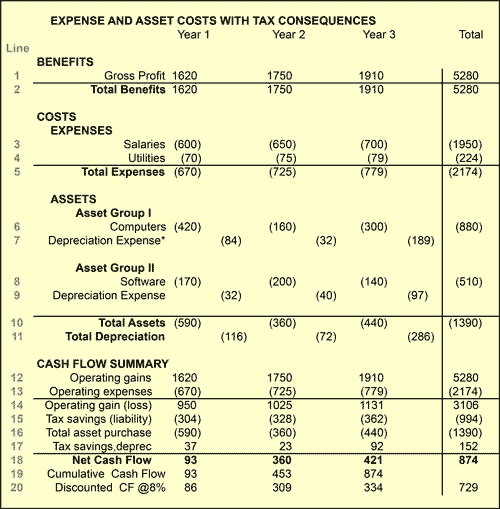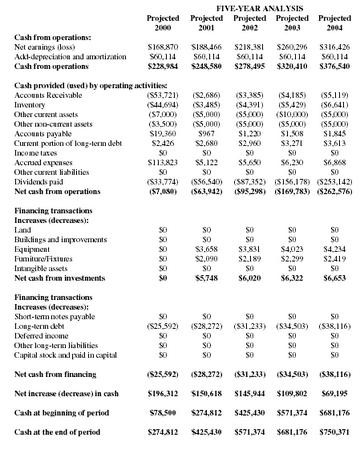Cash Flow Statement Encyclopedia Business Terms
Post on: 3 Июль, 2015 No Comment

A cash flow statement is a financial report that describes the sources of a company’s cash and how that cash was spent over a specified time period. It does not include non-cash items such as depreciation. This makes it useful for determining the short-term viability of a company, particularly its ability to pay bills. Because the management of cash flow is so crucial for businesses and small businesses in particular, most analysts recommend that an entrepreneur study a cash flow statement at least every quarter.
The cash flow statement is similar to the income statement in that it records a company’s performance over a specified period of time. The difference between the two is that the income statement also takes into account some non-cash accounting items such as depreciation. The cash flow statement strips away all of this and shows exactly how much actual money the company has generated. Cash flow statements show how companies have performed in managing inflows and outflows of cash. It provides a sharper picture of a company’s ability to pay creditors, and finance growth.
It is perfectly possible for a company that is shown to be profitable according to accounting standards to go under if there isn’t enough cash on hand to pay bills. Comparing amount of cash generated to outstanding debt, known as the operating cash flow ratio, illustrates the company’s ability to service its loans and interest payments. If a slight drop in a company’s quarterly cash flow would jeopardize its ability to make loan payments, that company is in a riskier position than one with less net income but a stronger cash flow level.
Unlike the many ways in which reported earnings can be presented, there is little a company can do to manipulate its cash situation. Barring any outright fraud, the cash flow statement tells the whole story. The company either has cash or it does not. Analysts will look closely at the cash flow statement of any company in order to understand its overall health.
PARTS OF THE CASH FLOW STATEMENT
Cash flow statements classify cash receipts and payments according to whether they stem from operating, investing, or financing activities. A cash flow statement is divided into sections by these same three functional areas within the business:
- Cash from Operations this is cash generated from day-to-day business operations.
- Cash from Investing cash used for investing in assets, as well as the proceeds from the sale of other businesses, equipment, or other long-term assets.
- Cash from Financing cash paid or received from issuing and borrowing of funds. This section also includes dividends paid. (Although it is sometimes listed under cash from operations.)
- Net Increase or Decrease in Cash increases in cash from previous year will be written normally, and decreases in cash are typically written in (brackets).
Although cash flow statements may vary slightly, they all present data in the four sections listed here.
CLASSIFICATIONS OF CASH RECEIPTS AND PAYMENTS
Cash from Financing
At the beginning of a company’s life cycle, a person or group of people come up with an idea for a new company. The initial money comes from the owners or is borrowed by the owners. This is how the new company is financed. The money that owners put into the company is classified as a financing activity. Generally, any item that would be classified on the balance sheet as either a long-term liability or an equity would be a candidate for classification as a financing activity.
Cash from Investing
The owners or managers of the business use the initial funds to buy equipment or other assets they need to run the business. In other words, they invest it. The purchase of property, plant, equipment, and other productive assets is classified as an investing activity. Sometimes a company has enough cash of its own that it can lend money to another enterprise. This, too, would be classified as an investing activity. Generally, any item that would be classified on the balance sheet as a long-term asset would be a candidate for classification as an investing activity.
Cash from Operations
Now the company can start doing business. It has procured the funds and purchased the equipment and other assets it needs to operate. It starts to sell merchandise or services and make payments for rent, supplies, taxes, and all of the other costs of doing business. All of the cash inflows and outflows associated with doing the work for which the company was established would be classified as an operating activity. In general, if an activity appears on the company’s income statement, it is a candidate for the operating section of the cash flow statement.
Methods of Preparing the Cash Flow Statement
In November 1987, the Financial Accounting Standards Board (FASB) issued a Statement of Financial Accounting Standards which required businesses to issue a statement of cash flow rather than a statement of changes in financial position. There are two methods for preparing and presenting this statement, the direct method and the indirect method. The FASB encourages, but does not require, the use of the direct method for reporting. The two methods of reporting affect the presentation of the operating section only. The investing and financing sections are presented in the same way regardless of presentation methods.
Direct Method
The direct method, also called the income statement method, reports major classes of operating cash receipts and payments. Using this method of preparing a cash statement starts with money received and then subtracts money spent, to calculate net cash flow. Depreciation is excluded altogether because, although it is an expense that affects net profits, it is not money spent or received.
Indirect Method

This method, also called the reconciliation method, focuses on net income and the net cash flow from operations. Using this method one starts with net income, adds back depreciation, then calculates changes in balance sheet items. The end result is the same net cash flow produced by the direct method. The indirect method adds depreciation into the equation because it started with net profits, from which depreciation was subtracted as an expense.
Regardless of whether the direct or the indirect method is used, the operating section of the cash flow statement ends with net cash provided (used) by operating activities. This is the most important line item on the cash flow statement. A company has to generate enough cash from operations to sustain its business activity. If a company continually needs to borrow or obtain additional investor capitalization to survive, the company’s long-term existence is in jeopardy.
FINANCING AND INVESTING SECTIONS
The cash flows, in and out, resulting from financing and investing activities are listed in the same way whether the direct or indirect method of presentation is employed.
Cash Flows from Investing
The major line items in this section of the cash flow statement are as follows:
- Capital Expenditures. This figure represents money spent on items that last a long time such as property, plant, and equipment. When capital spending increases, it often means the company is expanding.
- Investment Proceeds. Companies will often take some of their excess cash and invest it in an effort to get a better return than they could in a savings account or money market fund. This figure shows how much the company has made or lost on these investments.
- Purchases or Sales of Businesses. This figure includes any money the company made from buying or selling subsidiary businesses and will sometimes appear in the cash flows from operating activities section, rather than here.
Cash Flows from Financing
The major line items in this section of the cash flow statement include such things as:
- Dividends Paid. This figure is the total dollar amount the company paid out in dividends over the specified time period.
- Issuance/Purchase of Common Stock. This is an important number because it indicates how a company is financing its activities. New, rapidly growing companies will often issue new stock and dilutes the value of existing shares in so doing. This practice does, however, give a company cash for expansion. Later, when the company is more established it will be in a position to buy back its own stock and in this way increase the value of existing shares.
- Issuance/Repayments of Debt. This number tells you whether the company has borrowed money during the period or repaid money it previously borrowed. Borrowing is the main alternative to issuing stock as a way for companies to raise capital.
The cash flow statement is the newest of the three fundamental financial statements prepared by most companies and required to be filed with the Securities and Exchange Commission by all publicly traded companies. Most of the components it presents are also reported, although often in a different format, in one of the other statements, either the Income Statement or the Balance Sheet. Nonetheless, it offers the manager, investor, lender, and supplier of a company a view into how it is doing in meeting its short-term obligations, regardless of whether or not the company is generating income.
BIBLIOGRAPHY
Brahmasrene, Tantatape, and C. David Strupeck, Donna Whitten. Examining Preferences in Cash Flow Statement Format. The CPA Journal. October 2004.
Hey-Cunningham, David. Financial Statements Demystified. Allen & Unwin, 2002.
O’Connor, Tricia. The Formula for Determining Cash Flow. Denver Business Journal. 2 June 2000.
Taulli, Tom. The Edgar Online Guide to Decoding Financial Statements. J. Ross Publishing, 2004.
Ten Ways to Improve Small Business Cash Flow. Journal of Accountancy. March 2000.














